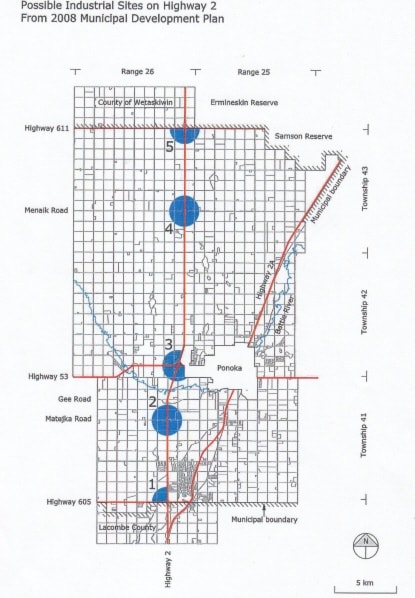Ponoka County’s Highway II corridor study and development plan is falling into place, as five major highway intersections have been highlighted for encouraged development in the area.
County CAO Charlie Cutforth contracted Bob Riddett, a retired manager of West Central Planning Agency, to spearhead the special project.
Other counties up and down the highway corridor are already taking advantage of their location to the heavily traveled road to entice business of commercial and industrial nature, and Ponoka County council is ready to take that step as well.
“I think the driving force behind this is that a lot of businesses want and need good road access, paved highways that are well maintained, not too many road bans,” said Riddett.
The five intersections along Highway II within the county are Highway 53 on the west and southeast sides, secondary highways 611 and 605, Matejka Road and Menaik Road. “At Charlie’s request, we looked at whether we should allow this in Ponoka County, what the rules might be, what sort of businesses we might expect to get in these locations,” Riddett told council.
Council was recommended to reserve the areas for businesses that would benefit most from the exposure along Highway II and dictate with a list of approved uses in the land use bylaw.
Acceptable uses would include, but not be limited to, warehouses, recreational vehicle sales and rentals, auction marts, trade shops, truck stops, gas stations, restaurants, and hotels and motels.
“My guess is hotels and motels might be a bit iffy,” said Riddett. He feels it would be unlikely to acquire municipal sewer and water at the locations, with the exception of Highway 53; he doesn’t want any business that would consume huge amounts of water because most will be on well systems.
Riddett says, to move forward, the county must produce an area structure plan for each intersection or possible each quarter section as well as for improvements the Alberta Government may want to make to the roads in the future.
When he ran the idea past Alberta Transportation, he was told to not include Gee Road in the project. “They said forget Gee Road intersection, it only works in one direction and they’re not sure how long that one’s going to remain open. But the other five intersections, they have no problems with.”
“If Highways had said no, the thing would be dead, but Highways said yes as long as we do some more detailed planning at the subdivision stage,” he added.
Three of the locations are designated provincial highways, but Riddett says the project has clearance across the board if the county wished to proceed in this direction.
Open House for landowners
“One of the things we have to be careful about, of course, is these things don’t exist in a vacuum. There are neighbours who may be concerned about traffic or noise . . . So the neighbours certainly have to have their input, too, if anything like this is proposed (and) before it’s approved,” said Riddett.
Riddett says the county’s land use bylaw contains a provisional reservation, which stipulates that granting a permit, a development office can impose conditions to protect the value and life enjoyment of nearby properties.
“I would think the next step would be to advertise this and invite the affected landowners for an open house at the county (office),” said Riddett. Council set an open house for April 3 from 1 to 4 p.m. where land owners will be able to speak with Riddett about the project in a less formal, open atmosphere.
